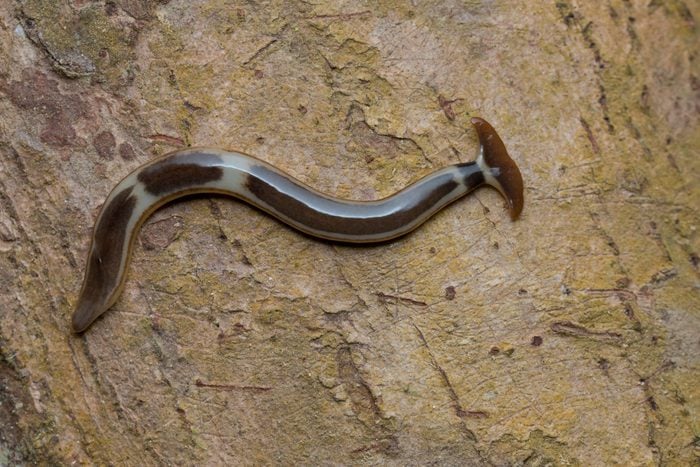What Is a Hammerhead Worm?
Updated: Mar. 10, 2022

If you come across a hammerhead worm in your home or garden, read this before taking action.
Slithering their way over terrain with a bulbous, mushroom-shaped cranium, hammerhead worms (AKA arrowhead flatworms, land planarians or “landchovies”) are always on the hunt for their favorite meal: slugs, soil-dwelling insect larvae, common earthworms and — when the pickings are slim — other hammerhead worms!
What makes this cannibalistic creature more gruesome than your standard, everyday garden worm is the way it kills its victims. It stuns them with a sticky, neurotoxin that incapacitates and then liquefies them for easier digesting.
“They are capable of producing a toxin, tetrodoxin, that can be harmful if touched or consumed, says Katelyn A. Kesheimer, Ph.D., assistant professor & extension specialist at the Alabama Cooperative Extension System, Auburn University.
“It’s uncommon in terrestrial animals like this, as we more often see this toxin in aquatic creatures. This toxin is used to induce paralysis in a prey item. In the case of these flatworms, they use it to help subdue earthworms.”
On This Page
What Are Hammerhead Worms?
Native to Indochinese Peninsula in Southeast Asia, the hammerhead worm (Bipalium kewense) is an invertebrate animal with a soft, flattened, elongated body without appendages. “Hammerhead worms get their name from the unique head shape, resembling a hammerhead shark, and are typically a gray or tan color,” Kesheimer says.
The terrestrial planarian is predominately found in tropical and subtropical habitats. Hammerhead worms were recently spotted in France and Italy as well. They’re nocturnal in nature, emerging as the sun goes down or after heavy rain.
Outside of greenhouses, hammerhead worms are mostly found in the Southern coastal regions of the U.S. First emerging in the early 1900s in Louisiana, these worms have been reported as far north as the Missouri Ozarks.
Are Hammerhead Worms Dangerous?
Although believed to be harmless to humans, they do secrete a potent toxin that can cause minor skin irritation on contract.
“Because we don’t know the amount of toxin on the hammerhead worms, it’s best to avoid touching or allowing pets to consume in your yard,” Kesheimer says. “If you are touching them to remove from the garden, wear gloves, use a plastic bag or otherwise protect your skin.”
What Impact Do Hammerhead Worms Have on Lawns and Gardens?
Kesheimer says hammerhead worms don’t directly hurt backyard landscapes, vegetable gardens and ornamental plants.
“We have no evidence of hammerhead worm damage (tunneling, root feeding, etc.) directly on the lawn itself,” Kesheimer says.
However, the ecological peril the hammerhead presents to earthworms does make this creepy crawler problematic.
“Laboratory studies have confirmed that hammerhead worms will prey on earthworms,” Kesheimer says. “And we all know how earthworms help contribute to soil health, so we don’t want anything removing those from our lawns or gardens.”
What Are the Signs of a Hammerhead Worm Infestation?
These worms are long — around 12 to 15 inches — and skinny, so you’re unlikely to miss one! Some signs of a hammerhead infestation include:
- Worms hiding underneath rocks, logs, leaves or in other cool, damp areas. Similar to other worms, they are more active following a soaking rain.
- Telltale slime trails.
- Bright, tiny red or black eggs in cocoons or abandoned egg cases.
How To Get Rid of Hammerhead Worms
The good news? Kesheimer says hammerhead worms haven’t done anywhere near the damage as invasive species like brown marmorated stink bug or fire ants. But where there’s one worm, there are sure to be more.
“If you find some in your backyard, resist the urge to cut them in half with your trowel,” Kesheimer warns. “They can reproduce asexually, so you may end up with two worms.”
Capture the worm in a sealable plastic bag or airtight jar. Kill it using one of the methods below, then dispose of it, tightly-sealed container and all.
Salt or vinegar
Sprinkle a little salt or vinegar on the worm. It will dry out and die. “Only a small amount is needed, and be careful not to harm any nearby vegetation,” Kesheimer says.
Oil
Spray with citrus or neem oil.
Freeze
Place worms inside a tightly-sealed container and stick it in the freezer for at least 48 hours.
How To Prevent Hammerhead Worms
To keep these lengthy buggers from establishing themselves, Kesheimer recommends inspecting potted plants, trees, shrubs or sod grasses in and around your garden.
“Given hammerhead worms’ limited mobility, if you are careful to bring in only clean plants, your risk of ever finding them will be low,” she says.
Should You Call an Exterminator?
“There is no reason to call an exterminator,” Kesheimer says. “We don’t see large enough populations that cannot be easily, mechanically removed.”
